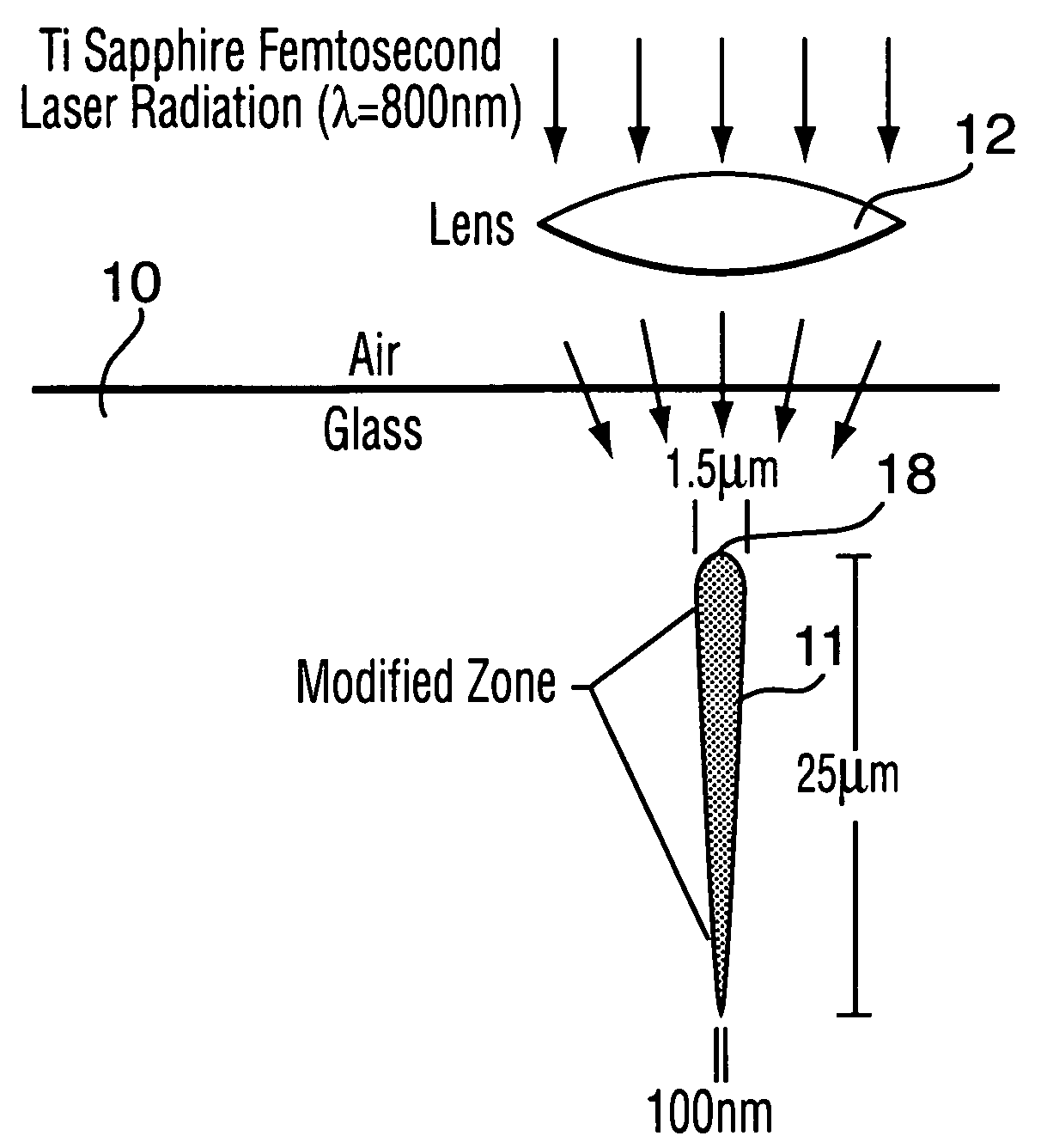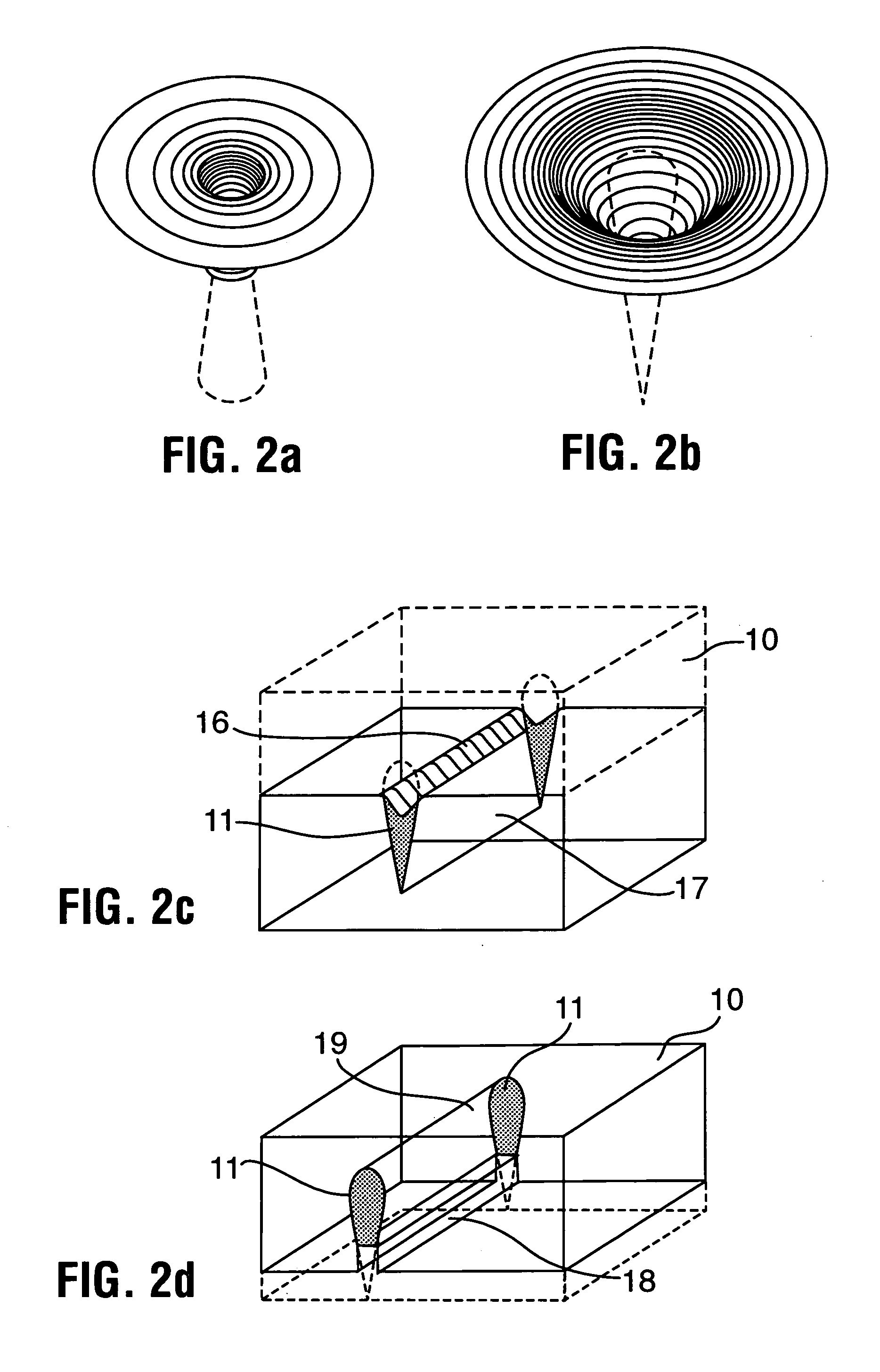Method of fabricating sub-micron structures in transparent dielectric materials
a dielectric material and sub-micron technology, applied in the field of microstructure fabrication, can solve the problems of difficult to achieve the fabrication of waveguides that extend from the surface deep into the substrate, cannot be used to form low-loss optical waveguides, and severely restrict the distance between the lens and the irradiated zone, etc., to achieve the effect of small width, increased width and different symmetry
- Summary
- Abstract
- Description
- Claims
- Application Information
AI Technical Summary
Benefits of technology
Problems solved by technology
Method used
Image
Examples
example 1
Fabrication of Photonic Components: A Variable Optical Attenuator
[0083]The combination of a channel with an adjoining waveguide can be used to fabricate a temperature controlled variable attenuator for telecom applications as shown in FIGS. 5a to 5c. In this application a channel 20 created by femtosecond laser writing followed by selective chemical etching (FIG. 5(b)) is partially filled with a polymer 21 (FIG. 5(c)) whose index of refraction is less than that of the waveguide core and which has a temperature dependent absorption at e.g. λ=1.5 μm. The polymer 21 could also be from a class of polymers with large thermo-optical responses leading to large index of refraction changes as the polymer is heated. The index gradients can be made sufficiently large to deflect light out of the waveguide.
[0084]A metal coating 22 is subsequently deposited on top of the polymer and the entire surface is polished to remove the metal and polymer everywhere except in the channels. The small cross-s...
example 2
Microfluidic Applications on a Silica Chip
[0086]The method in accordance with the invention permits the production of precise channels, which can be tapered and formed into complicated patterns such as mixing chambers for chemistry on a chip experiments.
[0087]The value of these narrow channels for chemistry on a chip experiments is enhanced since with each channel there is an adjoining optical waveguide, which can couple light into or out of the channel. One could also use arrays of micron-sized holes to trap very small droplets of liquid for analysis.
[0088]It is also possible to partially coat the interior of the channels / holes with metal. The metal is then removed everywhere except in the channels / holes by polishing. Laser radiation delivered through the waveguides attached to the channels / holes can be absorbed by the metal to control the temperature of samples placed in such channels / holes. The laser radiation can also be used heat the samples sufficiently rapidly to eject the ma...
example 3
Biological Sensing Applications on a Chip
[0089]Very small volumes of biological material can be inserted into the narrow channels where it can be interrogated by light traveling in the waveguide adjoining the channel.
[0090]There are also biological sensor applications for holes and their vertically connected waveguides. For example, biological specimens could be inserted into the holes. An entire array of holes could then be irradiated with UV light and the fluorescence from each specimen could be guided by its own waveguide for selective detection. Alternatively holes containing a sample could be individually irradiated or sampled through its own waveguide.
[0091]It is also possible to use light traveling in a horizontal waveguide, which has no adjoining channel but instead interfaces with a series of holes, to simultaneously irradiate material contained in all of the holes. Light emanating from each hole e.g. fluorescence, can be detected using the dedicated vertical waveguides adj...
PUM
| Property | Measurement | Unit |
|---|---|---|
| diameter | aaaaa | aaaaa |
| diameter | aaaaa | aaaaa |
| thickness | aaaaa | aaaaa |
Abstract
Description
Claims
Application Information
 Login to View More
Login to View More - R&D
- Intellectual Property
- Life Sciences
- Materials
- Tech Scout
- Unparalleled Data Quality
- Higher Quality Content
- 60% Fewer Hallucinations
Browse by: Latest US Patents, China's latest patents, Technical Efficacy Thesaurus, Application Domain, Technology Topic, Popular Technical Reports.
© 2025 PatSnap. All rights reserved.Legal|Privacy policy|Modern Slavery Act Transparency Statement|Sitemap|About US| Contact US: help@patsnap.com



